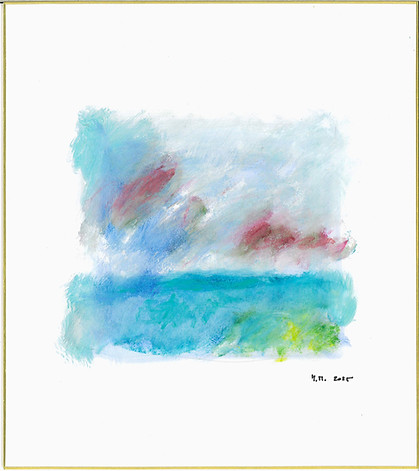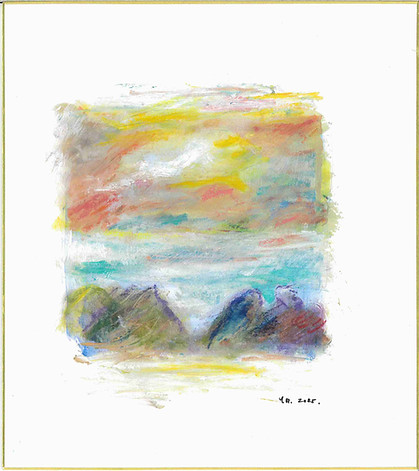

Yves Millet : Artist Profile.

Yves Millet, a French contemporary artist, is joining the Shikishi Art Project with pastel works on Japanese shikishi boards. He studied at the École des Beaux-Arts in Nantes, earning a National Diploma in Fine Arts in 1989. In 1999, he obtained his PhD in Art and Philosophy of Art from the University of Paris I – Panthéon-Sorbonne, with a thesis titled Jean Grenier et l’esprit du Tao, le non-agir comme raison de l’œuvre (Jean Grenier and the Spirit of Tao: Non-Action as the Reason for the Work), establishing his long-term engagement with East Asian art and philosophy.
From 1998 to 2015, Yves Millet lived in Seoul, South Korea, teaching at Hankuk University of Foreign Studies and publishing different comparative and environmental aesthetics papers. In 2008, he was a visiting professor at Kobe College in Japan, deepening his connection with Japanese artistic traditions. His scholarly work includes the essay Performance(s) : Gutai en perspective, which offers a critical exploration of the Gutai movement—a post-war avant-garde group founded in 1954 in Japan.
In 2016, he returned to Brittany, France, where he continues to create and exhibit his work.
Yves Millet co-directs the publishing house L’Atelier des Cahiers, which he co-founded. This independent publisher specializes in works on East Asia—particularly Korea—covering literature, essays, travel writing, art, and cultural studies, often with a cross-cultural perspective.

Analysis of Technique and Painting
Millet’s practice reveals a precise balance between intellectual rigor and sensory exploration. His paintings are built around a restrained yet vibrant palette, where subtle tonal shifts evoke the rhythms of light, season, and place. Layers of pastel—both soft and oil—are worked to create a textured surface that captures light differently depending on the viewer’s position. His compositions often use simplified forms and open spaces, allowing the colour fields to breathe. A hallmark of his technique is the way he unites structured composition with painterly fluidity: lines or shapes may suggest a horizon, foliage, or water, yet they resist full definition, inviting the imagination to participate. The influence of East Asian aesthetics is visible in his emphasis on suggestion over depiction, the integration of empty space, and the poetic interplay between form and void.
Artist Statement
“My painting or pastels are first and foremost a space for exploring the suggestive power of colour through various simple motifs—initial impulses often drawn from landscapes or elements within them. I focus on the poetic uniqueness of sensory experiences that connect us to the living world, seeking to capture their rhythms, punctuations, and variations in intensity. Each work, where memory and observation mingle, is a journey toward the unknown that concludes when a form of suggestion is reached—one in which each painting, in my eyes, might claim to be the equivalent of a poem; a poem that, according to Wallace Stevens, ‘should stimulate the sense of living and of being alive.’”
Shikishi Art Technique
In Japanese tradition, a shikishi is an art board made of three
layers of washi paper framed with a thin gold border. Historically used for calligraphy and painting, shikishi have been appreciated for centuries as a refined support for poetry,
ink painting, and seasonal greetings. Their formal proportions
and tactile surface invite a concentrated, intimate mode of creation.
Yves Millet reinterprets this traditional format through a personal technique combining soft and oil pastels with specific binders. The absorbent yet resilient surface of the washi allows for layered applications, creating depth and subtle transitions of tone.
His first series of shikishi works, titled 'Seascape', combines abstraction and evocation, favouring light, texture, and chromatic rhythm. His works transform landscapes into atmospheres and colour sequences, encouraging a contemplative gaze.

Further informations : https://yvesmillet.myportfolio.com/


Frequently Asked Questions about Yves Millet
Who is Yves Millet?
Yves Millet is a French contemporary painter and pastel artist, known for his refined seascapes and landscapes. His work blends abstraction with evocation, focusing on the interplay of light, colour, and atmosphere.
What is Yves Millet’s background?
He studied at the École des Beaux-Arts in Nantes and earned a Doctorate in Art and Philosophy of Art from the University of Paris I – Panthéon-Sorbonne. His thesis, Jean Grenier et l’esprit du Tao, explored East Asian philosophy and aesthetics.
Has Yves Millet worked internationally?
Yes. Millet lived in South Korea for over fifteen years, where he pursued his research on comparative and environmental aesthetics at Hankuk University. He also worked as a visiting professor at Kobe College in Japan, deepening his connection to Japanese art traditions.
What is the Shikishi Art Project?
The Shikishi Art Project is an initiative at Art San Gallery where selected artists reinterpret the traditional Japanese shikishi board in contemporary art. Yves Millet’s contributions use layered pastel techniques to explore seasonal themes and atmospheric landscapes.
Where has Yves Millet exhibited his work?
He has exhibited in France, including at the Médiathèque de Port-Louis, Château du Parc Anger in Redon, and Galerie FMR in Port-Louis.















